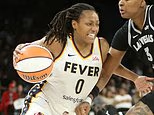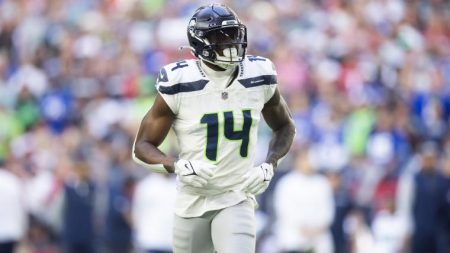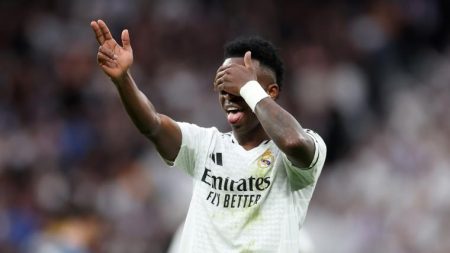The Emergence of Tarris Reed Jr.
On a mild Wednesday evening in Stannis, Connecticut, Tarris Reed Jr. emerged from the tunnel at Gampel Pavilion, his imposing presence commanding attention. Standing at 6-foot-10 and weighing 260 pounds, Reed’s physique suggests a formidable barrier to any opponent attempting to breach UConn’s interior defense. His legs, thick like tree trunks, and his rippling biceps speak to his raw strength and potential. Yet, beyond the physical, it’s the friendly smile that often adorns his face that makes him stand out. This contrast was vividly displayed in the game against No. 20 Marquette, where Reed’s inconsistency transformed him from a dominant force in the post to a player struggling to stay on the floor. Reed’s performance underscores the mental and emotional journey he has been on, navigating the pressures of high-level college basketball and adapting to the rigorous demands of his new team.
From Dominant Force to Lapse in Focus
Only 96 hours prior, Reed had showcased his best, recording a staggering 24 points, 18 rebounds, and six blocks in a win against Providence. Such a stat line is a rarity, having been matched only 16 times in the past two decades. However, when the clock ticked down to the 12:20 mark of the first half against Marquette, Reed’s game took a significant turn for the worse. He was beaten down the floor by Marquette center Ben Gold, who capitalized on Reed’s momentary lapse in concentration to score a transition dunk, converting a traditional three-point play and earning Reed a quick benching. Later, Reed’s failure to secure a defensive rebound led to another foul and his early exit from the game. UConn’s early lead quickly dissipated, leaving them trailing by four points at halftime. Reed’s inconsistency is a critical factor that can either elevate the team to the second weekend of the NCAA Tournament or see them fall short in the first round.
Mental Struggles and Untapped Potential
Hurley has been vocal about Reed’s potential, emphasizing that his issues are primarily mental rather than physical. A native of St. Louis, Missouri, Reed developed his skills in a city known for its basketball prowess. He was a four-star recruit and the 35th overall player in the 2022 class, with offers from many top-tier programs. His two seasons at Michigan, however, were marred by the team’s struggles, and he never experienced the NCAA Tournament. Reed’s averages of 9 points and 7.2 rebounds per game for a 2021-2022 squad that finished 8-24 were a testament to his talent, but also to the negative habits he developed. Upon transferring to UConn, Reed encountered a vastly different coaching philosophy. Hurley’s emphasis on schematic precision and relentless intensity was initially challenging for Reed, who had grown accustomed to a different style of play. The adjustment was difficult, and there were moments when Reed doubted his ability to fit into Hurley’s system. However, he found solace in the Bible and gradually began to embrace his role as a dominant force in the paint.
A New Partnership and Personal Growth
Reed’s journey at UConn has been marked by personal growth and a newfound partnership with Samson Johnson, the team’s starting center. Johnson, a senior, averages 7.2 points and 3.2 rebounds per game, and together, they form a formidable interior tandem. Reed admits to having struggled with jealousy during his time at Michigan when he had to share minutes with fellow big men. At UConn, however, his relationship with Johnson has evolved into a close friendship. Johnson’s performance against Marquette, clinching his first double-double with 11 points and 10 rebounds, demonstrated the value of their combined efforts. Reed’s supportive reaction from the bench, loudly cheering for Johnson, highlighted the team’s unity and his personal progress. The chemistry between the two players is crucial as UConn aims to continue its championship legacy.
The Importance of Consistency
Reed’s inconsistency has been a double-edged sword for the Huskies. When he is at his best, UConn’s team looks like a legitimate contender for the NCAA Tournament’s later rounds. Reed’s dominant performances, such as the one against Providence, offer a glimpse of what the team can achieve. Conversely, his lack of focus and energy, evident in the Marquette game, can be detrimental. Reed’s ability to perform consistently is essential for UConn’s success. Hurley and his staff have been relentless in pushing Reed to reach his full potential, recognizing his immense talent and the impact it can have on the team. The junior’s willingness to adapt and improve is a positive sign, especially as the regular season winds down and the stakes rise. The Huskies need Reed to bring the same motor and ferocity to every game if they hope to make a deep tournament run.
Preparing for the Future
With just one regular-season game remaining against Seton Hall, Reed and Johnson are combining for respectable averages of 17.2 points, 10.5 rebounds, and 3.2 blocks per game. Their performance metrics make them the highest-rated center pairing in the Big East, according to EvanMiya.com, though neither ranks among the top five centers individually. This statistic underscores the depth and talent UConn has had at the center position over the past three years, a period during which they won back-to-back national championships. As Reed continues to develop, his contributions will be crucial in UConn’s quest for a three-peat. Marquette head coach Shaka Smart acknowledges the potency of the Huskies’ frontcourt, calling them a "really, really good two-headed monster." Reed’s ability to impact winning, whether through scoring, rebounding, or defensive presence, will be pivotal as UConn heads into the postseason.











